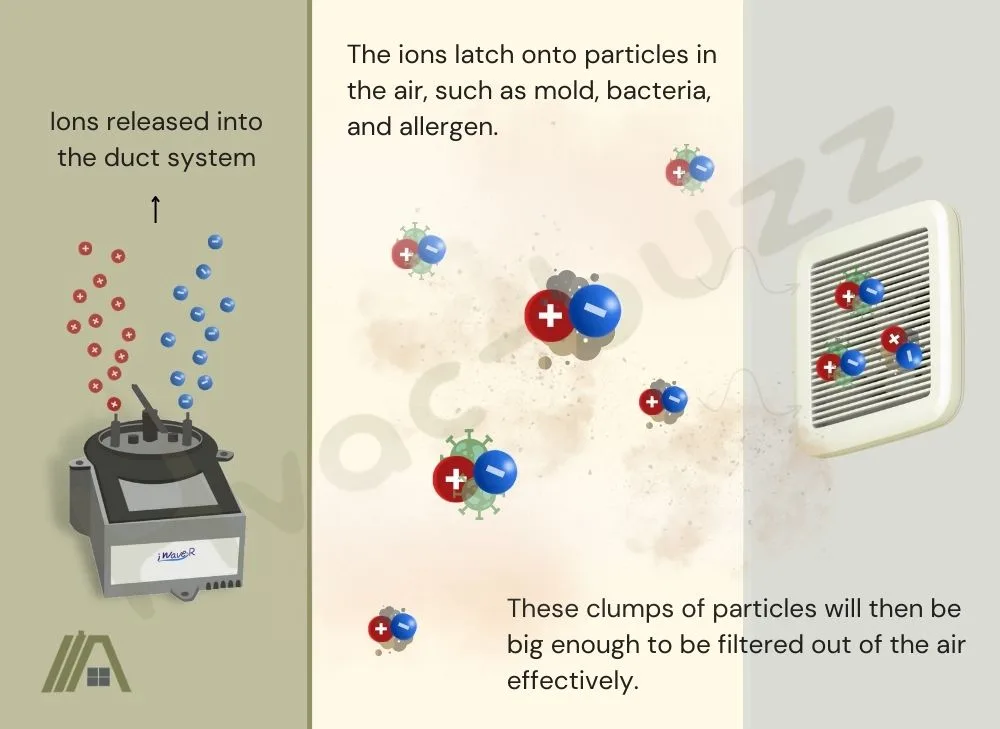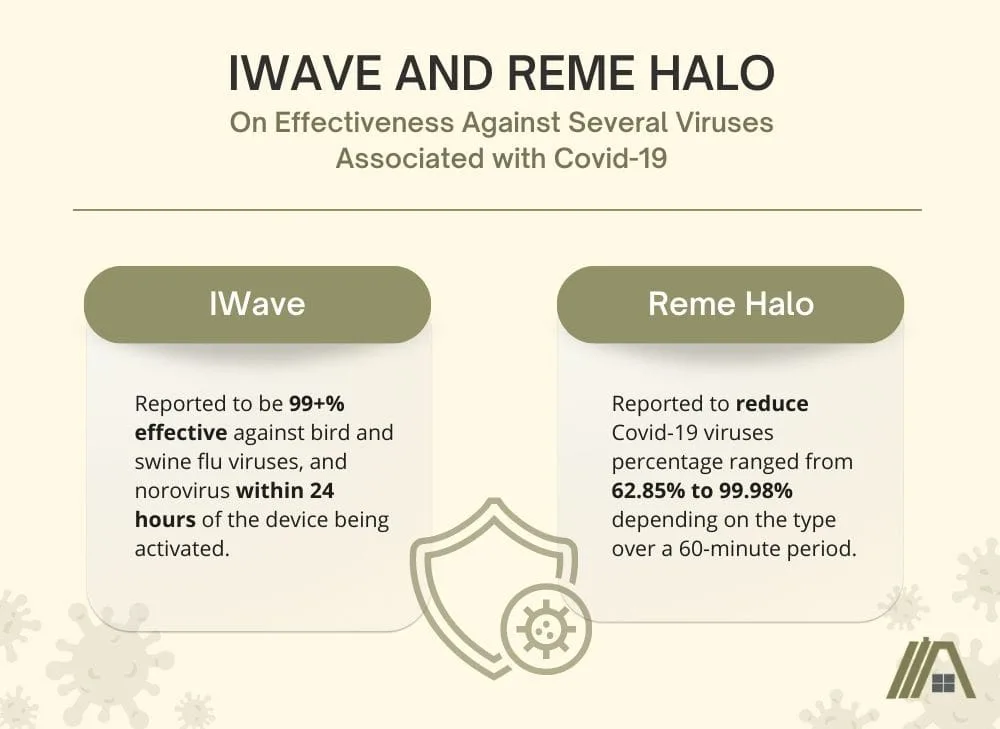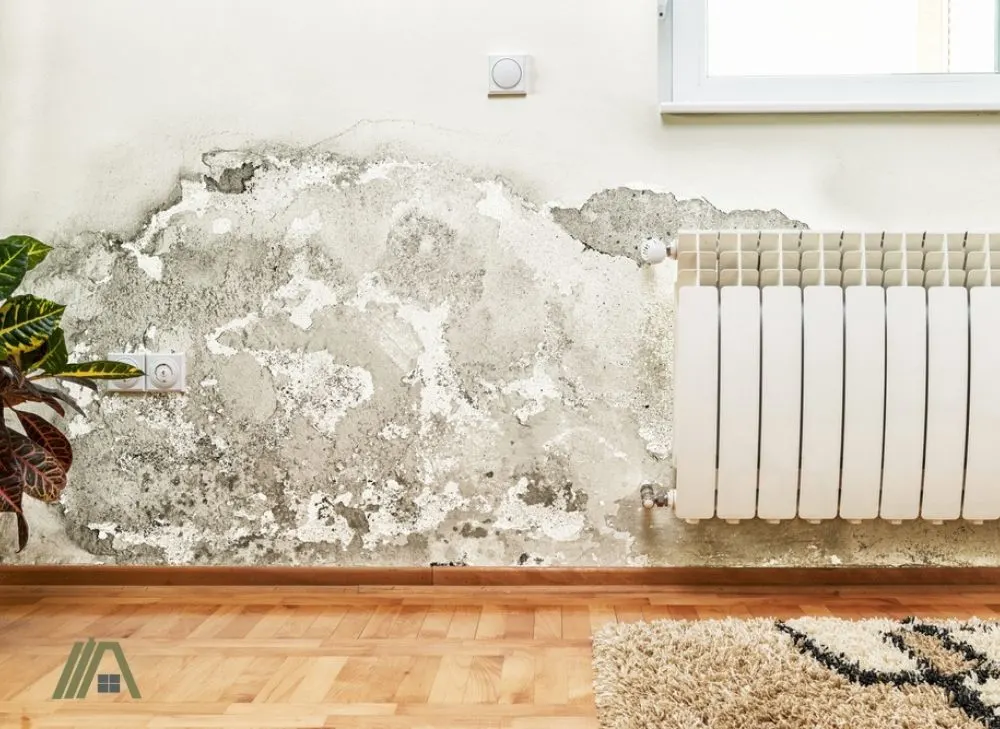Air purifiers are a great solution for anyone looking to keep the air in their building clean and pure. IWave and Reme Halo are two leading brands of air purifiers, and there are many factors to consider when comparing the two.
In this article, we will examine several aspects of each product and compare the features of the two. This should give you everything you need to make an informed decision about these products.

IWave and Reme Halo units are comparable air ionizers. Their function, cost, installation, and performance are similar. The biggest differences are that IWaves require less maintenance, Reme Halos have been tested for effectiveness against more microbes, and the IWave produces less ozone.
IWave and Reme Halo Are Both Ionizers
Air purifiers such as IWave and Reme Halo work as ionizers. That is, they are devices that use ions purify the air.
How Do Ionizers Work?
Ionizers release negative ions into the air around them. As these ions spread out, they are able to latch onto other particles in the air, such as mold, bacteria, and allergens.
Once the ions are in contact with these particles, they can physically destroy them or give them electrical charges that cause the particles to stick together.
These clumps of particles are big enough to be filtered out of the air effectively. Some are even heavy enough that they settle on the nearest surface. Since the ions will now be sticking to surfaces in the ducts and on surfaces around the home, they will be much easier to clean. The air will be clear of particulates, making it safer and cleaner to breathe.

How Are the Ions Produced?
IWave products use needlepoint bipolar ionization. This is a type of technology that releases both positive and negative ions. The oppositely charged ions attract each other, which adds mass to particles in the air while weighing them down.
This technology allows the harmful particles to either fall to nearby surfaces, or be more easily filtered out of the ducts through the filtration system.
Reme Halo products use a combination of photohydroionization and ionization. Photohydroionization uses a catalyst and UV light to trigger a reaction that turns water molecules in the air into hydrogen peroxide. You can read more in my plain English explanation.
The hydrogen peroxide ions are able to attach to harmful particles in the air, “stealing” hydrogen ions from the cell walls of microbes, destabilizing and destroying them. The ions also cause allergens to clump together.
Both Installed in the HVAC System
Both IWave and Reme Halo air purifiers are installed in the HVAC ducts of the home. This ensures that the air is clean before it circulates around the home. It is also better for aesthetic purposes as the device is hidden from sight.
Although it is possible to install these devices on your own, it is not recommended. This is because it is easy to make a mistake when installing these devices, and this can result in the product working ineffectively. Self-installation also negates your warranty.
On average, the cost to have an air purifier installed can range from $150-$400 depending on how intricate the device is, its location, and the individual contractor.
It is recommended to get multiple estimates before choosing a contractor, as the price can fluctuate dramatically between places offering this service.
IWave vs Reme Halo: Cost Comparison
Currently, Amazon offers a Reme Halo air purifier device for the price seen below.
No products found.
This device’s airflow is 1,000-6,500 CFM and can be installed in any residential HVAC system, but it only has 24 volts of power.
When it comes to IWave, Amazon offers a comparable product to the Reme Halo as pictured and priced below.
Last update on 2024-03-27 / Affiliate links / Images from Amazon Product Advertising API
This product has a smaller airflow range (up to 2400 CFM), but it has 260 volts of power.
Besides the air purifiers themselves, there are other costs to take into account. This can include things like installation and shipping costs. These will depend on where you live and your home’s structure, among other things.
Maintenance
Reme Halo air purifier maintenance includes changing the cell about once every two years, and a replacement cell for the Reme Halo costs about $200.
In addition, experts recommend routinely checking the device to make sure it’s clean and working properly. This can be done either monthly or yearly, depending on your home’s needs.
IWave states that the device requires no maintenance after installation. However, it is still a good idea to routinely check the device to ensure that it is working properly.
For both air purifiers, an important part of maintenance is cleaning and maintaining the ducts in which they are installed. This will ensure that the particles being removed from the air aren’t kept sitting in the ducts.
Performance Comparison
Viruses
The Reme Halo is reported to be 99+% effective against all types of bacteria tested. These include two of the viruses associated with COVID-19, both the bird and swine flu viruses, and norovirus. All of these viruses were essentially inactivated within 24 hours of the device being activated.
The IWave was tested against several viruses associated with COVID-19, and the percentage net reduction ranged from 62.85% to 99.98% depending on the type over a 60-minute period.
The IWave was also about 84% effective against Influenza types A and B, and 94.71% effective against RSV. These statistics refer to a 60-minute period as well.

Bacteria
The Reme Halo was 99+% effective over 24 hours on a wide range of bacteria such as MRSA, tuberculosis, and salmonella, to name a few.
However, it was 90% effective for Streptococcus pneumoniae (a respiratory irritant) and 97% effective for the bacteria that causes strep throat over a 24-hour period.
The IWave was only tested against three types of bacteria. It was 91.55% effective against Staphylococcus aureus, which is a common bacteria that can cause many different illnesses ranging in severity. It was also 86.36% effective against E. coli, and 87.87% effective against MRSA, all over a 60-minute period.
Mold/Fungi
Stachybotrys chartarum is a mold and fungus commonly known as the black mold. It can be very dangerous for humans to breathe in its spores, as it can cause respiratory and flu symptoms in adults. It has also been linked to bleeding of the lungs in infants. The Reme Halo is reported to be 99+% effective at inactivating it in 24 hours.
In addition, the Reme Halo was found to be 97-98% effective at inactivating mold overall in 48 hours. Refer to this article for more information.
The IWave doesn’t have any data published by the manufacturer about its effectiveness against mold or fungus, so it is unclear whether or not this device will work by inactivating these particles.
Particulate Matter
The Reme Halo reportedly reduced the number of 0.1 um particulate matter to only 1,000 particles per cubic meter in 24 hours. While they don’t report on what particulate matter this includes, one can assume it includes typical allergens as the Reme Halo specifically claims to reduce allergies.
In addition, there are results from tests on a fuel source, and the burning of fuels is linked to particulate matter production. The device was found to be 85+% effective against ethylene particles after a 12 hour period.
The iWave’s efficiency against particulate matter was tested and compared to filtration without an air purifier. Two tests were done on two different types of air filters.
The first test found that on average the iWave removed PM2.5 twice as fast as the air filter alone, and the second test found that PM2.5 was removed over 1.5 times faster than the air filter alone.
Ozone Emissions
Ozone is a harmful pollutant gas that several home appliances emit. However, appliances do not typically emit ozone at a level that is anywhere near harmful to human health.
The level of ozone that has been deemed safe and good is a range from 0-to 54 parts per billion (ppb). At this level, no precautions against ozone need to be taken.
The Reme Halo has been certified successful at passing the federal safety standards about ozone emissions. However, the device does emit a very small, insignificant amount of ozone gas, about 40 ppb.
The iWave is also certified to be safe against ozone emissions. It has met a standard of not producing more than 5 ppb of ozone.
Which Is Best?
Both are great air purifiers. Each has its set of pros and cons and, unfortunately, I cannot say which if the pros outweigh the cons for your particular situation. However, there are certain scenarios in which one is more clearly the winner.
In the category of ease of maintenance, the IWave wins. Not having to replace the cell means that you only have to keep an eye on it as opposed to actively maintaining it as is required with the Reme Halo. Furthermore, while the cost of the IWave and Reme Halo is similar, having to purchase new cells for the Reme Halo can raise the long-term cost.
If you have a mold problem or you previously had one and now you are sensitized to the mold spores or you just have a justifiable aversion to the thought that there could be mold in your home, then the Reme Halo is the better choice. This is not because the IWave is ineffective against mold, there is just no evidence to show that it is.

When it comes to ozone-producing appliances there are those that vehemently refuse to have them in their home (if they know that they produce ozone) and there are others who are happy to accept that manufacturers would not be allowed to produce and sell machines that generate harmful levels of the gas.
If you are part of the former group, or you are concerned for the safety of your pets, then the IWave is a better choice. They produce much less ozone.
Of course, you can also opt for the Reme Halo LED, which is completely ozone-free.
If you are looking for more information on Reme Halos, I have a complete guide that you can view here.
Sources
https://iwaveair.com/how-it-works/
https://iaq.works/purification/how-bipolar-ionization-works-and-improves-indoor-air-quality/
https://moaablogs.org/reme-halo-air-purifier-review/#Maintenance_Costs

